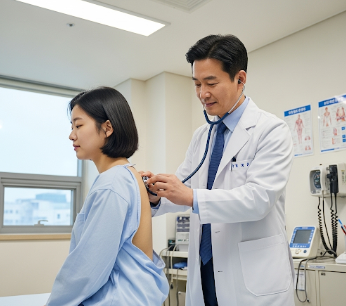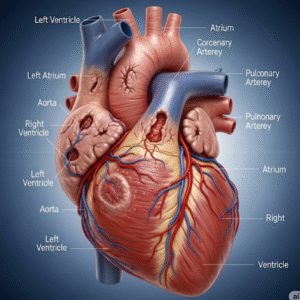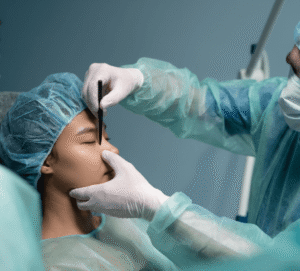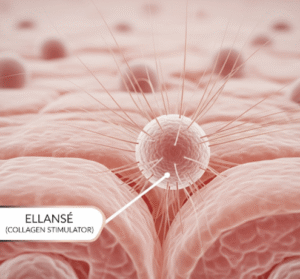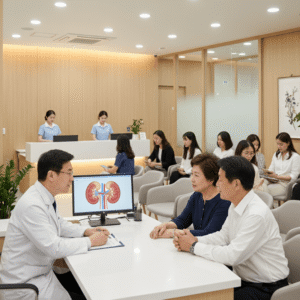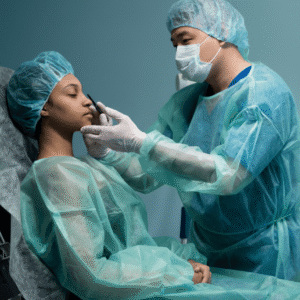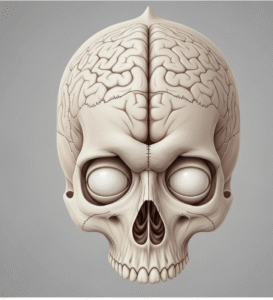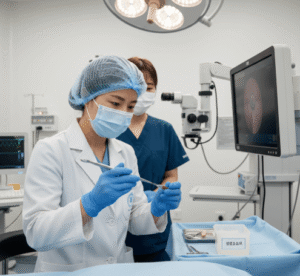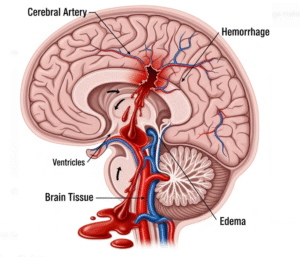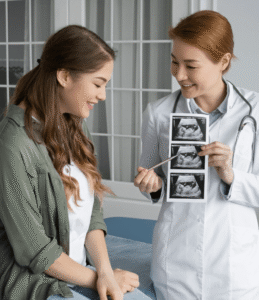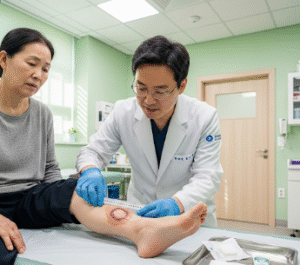Overview
Wheezing is a high-pitched whistling sound during breathing, usually heard when exhaling, though it can occur during inhalation in severe cases. It is a common respiratory symptom indicating airway narrowing or obstruction.
➤ Wheezing can be intermittent or persistent, mild or severe, and may be associated with cough, shortness of breath, or chest tightness.
➤ It is commonly seen in conditions such as asthma, chronic obstructive pulmonary disease (COPD), respiratory infections, or allergic reactions.
➤ In Korea, hospitals and clinics provide diagnostic tests, medication management, and advanced respiratory therapies for wheezing and related conditions.
Key Facts
► Definition: A high-pitched, musical sound produced by airflow through narrowed or obstructed airways.
► Prevalence: Frequently occurs in children with asthma and adults with COPD or allergies.
► Associated symptoms: Shortness of breath, cough, chest tightness, difficulty breathing, and fatigue.
► Risk factors: Asthma, allergies, respiratory infections, smoking, obesity, environmental pollutants.
► Treatment in Korea: Includes inhalers, oral medications, breathing therapies, and management of underlying conditions.
What Is Wheezing?
Wheezing is the result of turbulent airflow through narrowed respiratory passages, often due to inflammation, bronchoconstriction, or mucus accumulation.
➔ It may indicate reversible airway obstruction, as seen in asthma, or irreversible obstruction, as in chronic COPD.
➔ Wheezing can be episodic (triggered by allergens, infections, or exercise) or persistent, signaling a chronic condition.
➔ The sound is typically audible with a stethoscope but can sometimes be heard without one in severe cases.
What Symptoms Are Related to Wheezing?
Symptoms often vary depending on cause and severity:
→ Shortness of breath – Difficulty breathing, especially during exertion.
→ Coughing, which may be dry or productive.
→ Chest tightness or discomfort.
→ Noisy breathing – Wheezing heard on inhalation, exhalation, or both.
→ Fatigue or exercise intolerance due to limited airflow.
→ Symptoms worsening at night or early morning (common in asthma).
→ Associated allergies – Sneezing, nasal congestion, or itchy eyes.
Causes / Possible Causes of Wheezing
Respiratory Causes
➤ Asthma – Chronic airway inflammation causing reversible obstruction.
➤ Chronic obstructive pulmonary disease (COPD) – Persistent airway narrowing from chronic bronchitis or emphysema.
➤ Respiratory infections – Viral or bacterial infections leading to inflammation and mucus production.
➤ Bronchiolitis – Common in infants, usually viral in origin.
➤ Allergic reactions or anaphylaxis – Can cause acute airway narrowing.
Structural and Other Causes
➔ Foreign body aspiration – Especially in children, can cause localized wheezing.
➔ Tumors or airway obstruction – Masses compressing airways.
➔ Congenital airway malformations – Rare but possible in children.
Environmental and Lifestyle Factors
→ Exposure to smoke, dust, pollution, or chemical irritants.
→ Obesity – Can exacerbate airway obstruction.
→ Cold air or exercise – Triggers in susceptible individuals.
When Should I See My Doctor?
Seek immediate medical evaluation if wheezing:
➤ Is sudden, severe, or worsening rapidly.
➤ Causes shortness of breath, blue lips/fingertips, or inability to speak.
➤ Occurs with fever, chest pain, or signs of infection.
➤ Persists for weeks or months without clear cause.
➤ Early evaluation helps prevent respiratory failure, chronic lung damage, or severe asthma attacks.
Care and Treatment
Lifestyle and Self-Care Measures
► Avoid triggers such as smoke, allergens, or cold air.
► Maintain healthy weight and physical activity to support lung function.
► Use humidifiers or air purifiers to reduce environmental irritants.
► Practice breathing exercises to improve airway function.
Medical Treatments
➔ Inhaled bronchodilators (short-acting and long-acting) to relieve airway constriction.
➔ Inhaled or oral corticosteroids to reduce airway inflammation.
➔ Antihistamines or leukotriene inhibitors for allergy-related wheezing.
➔ Antibiotics if bacterial infection is confirmed.
➔ Emergency medications such as epinephrine in anaphylaxis.
Procedural and Advanced Interventions
→ Pulmonary function tests to evaluate airway obstruction.
→ Imaging – Chest X-ray or CT scan for structural causes.
→ Bronchoscopy for foreign body removal or airway evaluation.
→ Oxygen therapy for severe respiratory compromise.
Treatment Options in Korea
Diagnosis in Korea
➤ Physical examination and auscultation of the lungs.
➤ Pulmonary function testing and spirometry for asthma or COPD assessment.
➤ Allergy testing for trigger identification.
➤ Imaging for structural or obstructive causes.
Non-Surgical Care
► Use of inhalers, oral medications, and allergy management.
► Patient education on trigger avoidance and early recognition of flare-ups.
► Monitoring response to medications and adjusting doses.
Advanced Care
➔ Bronchoscopy or minor procedures for foreign body removal or airway lesions.
➔ Multidisciplinary management for severe asthma or COPD, integrating pulmonologists, allergists, and rehabilitation specialists.
➔ Oxygen therapy and respiratory support in acute exacerbations.
Rehabilitation and Lifestyle Support
→ Education on long-term asthma or COPD management.
→ Pulmonary rehabilitation programs to improve exercise tolerance and quality of life.
→ Ongoing monitoring for recurrent infections or worsening symptoms.
Korean hospitals combine expert pulmonologists, allergists, and respiratory therapists, advanced diagnostic tools, and patient-centered care to effectively manage wheezing and its underlying causes.

